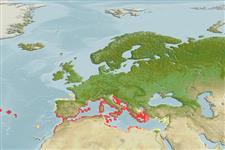Common names from other countries
>
Eupercaria/misc (Various families in series Eupercaria) >
Labridae (Wrasses)
Etymology: Labrus: Name from Latin 'labrum' for lip, rim or edge; referring to the big lips of the fishes of the genus (from Ovid and Pliny according to Petrus Artedi)..
More on author: Linnaeus.
Environment: milieu / climate zone / depth range / distribution range
Ökologie
seewasser riff-verbunden. Subtropical; 46°N - 20°N, 32°W - 36°E
Eastern Atlantic: Portugal to Morocco and Azores. Also in the Mediterranean.
Length at first maturity / Size / Gewicht / Alter
Maturity: Lm 17.5, range 15 - 20 cm
Max length : 45.0 cm SL Männchen/unbestimmt; (Ref. 4742); common length : 40.0 cm SL Männchen/unbestimmt; (Ref. 4742); max. veröff. Alter: 17 Jahre (Ref. 4742)
Adults are found around rocks and seaweeds. Sometime schooling, more solitary when older. Feed on sea urchins, ophiuroids, mollusks, crabs and worms. They reach maturity when 2 years old (15-20 cm). Spawn during February to May in western Mediterranean (Ref. 4742). Oviparous, distinct pairing during breeding (Ref. 205). Males build dish shaped nests and guard the eggs (Ref. 205).
Oviparous, distinct pairing during breeding (Ref. 205). Males build dish shaped nests and guard the eggs (Ref. 205).
Bauchot, M.-L., 1987. Poissons osseux. p. 891-1421. In W. Fischer, M.L. Bauchot and M. Schneider (eds.) Fiches FAO d'identification pour les besoins de la pêche. (rev. 1). Méditerranée et mer Noire. Zone de pêche 37. Vol. II. Commission des Communautés Européennes and FAO, Rome. (Ref. 3397)
IUCN Rote Liste Status (Ref. 130435)
CITES (Ref. 128078)
Not Evaluated
Bedrohung für Menschen
Harmless
Nutzung durch Menschen
Warning: mysqli::__construct(): (08004/1040): Too many connections in /var/www/html/includes/func_getlabel.php on line 46
Can't connect to MySQL database (fbapp). Errorcode: Too many connections
